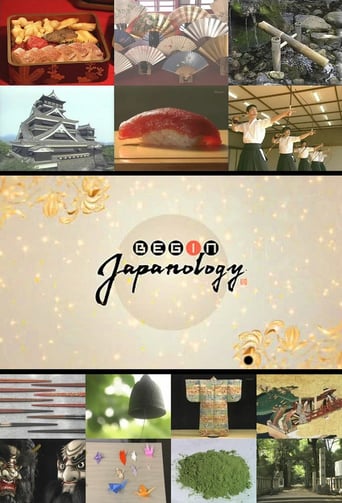Begin Japanology Season 6
BEGIN Japanology invites you into the world of Japanese culture, both traditional and modern, explaining how traditions evolved and the part they still play today in people's everyday lives.
With 30 Day Free Trial!
Begin Japanology
2008BEGIN Japanology invites you into the world of Japanese culture, both traditional and modern, explaining how traditions evolved and the part they still play today in people's everyday lives.
Watch Trailer
Begin Japanology Season 6 Full Episode Guide
The culture and business of used books has been important in Japan since around the 17th century. Today, the Jimbocho neighborhood of Tokyo has some 160 book dealers, many of them specialists, with a combined stock of 10 million volumes. Mass-market retailers that have simple systems for buying and selling used books are also part of the industry. On this edition of BEGIN Japanology, our theme is used books. We'll see how Japan's used book business has evolved in its own fascinating way.
Wherever you go to Japan, you will never be far from a convenience store and its vast range of products. An endeavor led by a Japanese businessman brought convenience stores to Japan from the US in the 1970's, and they have since acquired a clear Japanese identity. Each company invests heavily in private label products that can win in a fiercely competitive market. Recently, some convenience stores have begun offering services especially for mothers with small children, and for senior citizens.
Japan has various traditional wind instruments. Among the most familiar of them is the shakuhachi, which is essentially a hollowed-out length of bamboo. The sounds of the shakuhachi - reminiscent of such natural sounds as the wind through the trees, birdsong and the chirping of insects - have captivated the hearts of music lovers the world over. But in modern Japan the number of shakuhachi players is decreasing, and ingenious efforts are being made to keep the tradition going.
This month, we present a special talk-show series called Japanophiles, featuring lively interviews with foreigners living in Japan. Kenny Omega is a professional wrestler enjoying a successful career in Japan. As well as embracing the unique appeal of Japanese pro-wrestling, he is also a fan of Japan's popular culture. An ardent fan of manga, anime and video games, Omega even makes use of pop culture motifs in his wrestling moves - which are sometimes performed outside the confines of the ring.
This month, we present a special talk-show series called Japanophiles, featuring lively interviews with foreigners living in Japan. Many of Japan's mountain communities suffer from aging, shrinking populations. Karl Bengs is a German who moved 20 years ago to one such community, Takedokoro. Bengs is an architectural designer who specializes in renovating old Japanese houses. He has rebuilt several homes in Takedokoro so far, attracting new residents and breathing fresh life into the village.
This month, we present a special talk-show series called Japanophiles, featuring lively interviews with foreigners living in Japan. River sports have recently become much more popular in Japan, and one such sport is called "canyoning". In it, participants plummet down steep river gorges without a boat. Behind Japan's canyoning boom is Mike Harris, originally from New Zealand. Now Harris hopes to use canyoning and other outdoor sports to boost the local economy of the town he is based in.
In Japan, summertime is beer time. The Japanese like smooth, ice-cold beer that really hits the spot as you gulp it down. Beer came to Japan from the Netherlands in the 18th century. As the country modernized, beer gradually put down roots in Japanese life. It became the after-work drink of choice for the corporate warriors who supported Japan's post-war economic growth. But in recent years, beer consumption has dropped, and brewers are trying to engineer a revival in the drink's popularity.
Tasty regional food, an amusement park or even a beach-you can find all of these things along Japanese expressways. Japan's first expressways were built in the 1960's, and half a century later the network reaches all of the nation's prefectures, from Hokkaido to Okinawa. But Japan's expressways do have at least one unpopular feature: they're expensive to use. On the plus side, they have sophisticated service areas with truly impressive leisure facilities offering refreshment to auto travelers.
Japan's biggest lake: Lake Biwa. It is 4 million years old, a source of water for 14 million people, and home to over 10 aquatic creatures that are only found there. Lake Biwa contains rare freshwater pearls, its scenic landscape has captivated artists for centuries, and it also has spiritual significance. The lake's ecosystem has been threatened by water pollution and the introduction of invasive species, but locals have come up with some creative ideas to reclaim the environment.
This year, Japanese television broadcasting celebrates its 60th anniversary. The world's very first cathode ray tube TV was made in Japan, and Japanese TV technology continues to set the pace with televisions that offer super high definition, 3D images, and Internet connectivity. TV was long a focal point of family life, but as programming diversified many Japanese came to have their own personal TV set. These days, TV can even be enjoyed on mobile phones and car navigation systems.
Japan is the world's calculator superpower. Rivalries between Japanese companies to make calculators ever slimmer, lighter and cheaper eventually propelled Japan to the top, and Japanese manufacturers have led sales of calculators for over 30 years in many countries. Before the calculator came along, Japanese people did arithmetic on the abacus, and then used hand-cranked calculating machines. Even now, in the age of PCs and tablets, calculators are still essential in accounting jobs.
For the past quarter of a century, strawberries have been Japan's best-loved fruit. Distinctively sweet, plump and delicious, Japanese strawberries started to be grown for eating around the year 1900, thanks to the patient efforts of one man. Today, Japan grows about 170,000 tons of strawberries per year. In Japan, strawberry shortcake is the definitive Christmas treat. Strawberry cultivation methods honed in Japan are now contributing to the development of a remote region in Southeast Asia.
Pro wrestling battles take place every evening in rings across Japan-over 150 pro wrestling events are held every month. Japanese pro wrestling was launched by the popularity of one wrestler: Rikidozan. 60 years ago, he drove the Japanese people wild, lifting the country's spirits after its demoralizing defeat in the Second World War. The Japanese have been hooked on this thrilling form of entertainment ever since. There are many "student pro wrestlers" in universities across Japan. Every March, they take part in an intense "Student Pro Wrestling Summit." There is currently a large number of pro wrestling organizations in Japan, each with its own niche. But some of these organizations struggle to make ends meet, and some wrestlers now also work outside the ring. On this edition of BEGIN Japanology, our theme is pro wrestling. We'll explore the appeal of this popular entertainment, which blurs the line between fantasy and reality.
Parcel delivery is a private-sector service that delivers small items to your door. First established in Japan, this business now handles 3.4 billion items a year. The roots of the service can be traced back to a 1935 delivery service started by freight companies and what was then known as the Ministry of Railways. Today, the 5 largest delivery companies have logistics centers in about 9,600 places across Japan. Book a parcel delivery by phone: they'll come to your door to pick the package up, then deliver it almost anywhere in Japan the next day. One parcel delivery company has introduced a new service for senior citizens, combining shopping delivery and a check on the well-being of the buyer. On this edition of BEGIN Japanology, our theme is parcel delivery. With its very precise delivery schedule and a detailed service menu, parcel delivery embodies some of the best aspects of business done the Japanese way.
Pine trees grow all around Japan, and make essential contributions to the Japanese way of life. From pine trees come gourmet matsutake mushrooms and fine calligraphy ink. Since pines can grow in harsh conditions, they are frequently used as windbreaks for homes. Pine trees are also symbols of longevity and abundance. They are often called the "luckiest" tree in Japan. Unfortunately, pine trees have recently come under attack from a damaging pest that eats away their resin ducts. The search for ways to protect the pines is going on in various parts of Japan. In one city on Japan's northeastern coast, the tsunami that struck on March 11, 2011, swept away a historic pine grove...except for one single tree. This lone pine became a symbol of hope for the survivors of the disaster. On this edition of BEGIN Japanology, our theme is pine trees. They provide a window on Japanese lifestyles and ideas of beauty.
It is said that Japan has more types of bread than any other country. Buns in Japan are filled with custard cream, sweet bean paste, or even curry. Bread made its first appearance in Japan in the 16th century. It probably came along with a shipment of firearms, from a Portuguese ship that drifted ashore in southern Japan. In fact, the Japanese word for bread is "pan," which comes from the Portuguese. A new bread product in the late-19th century incorporated a traditional Japanese sweet into Western bread. It led to a surge in bread's popularity with the masses. Since then, Japanese bakers have continued to create recipes that suit Japanese tastes, making bread an integral part of the Japanese diet. On this edition of BEGIN Japanology, our theme is bread. We'll see how bread worked its way into a country that has a culture founded on rice, and explore the latest trends in Japanese baking.
Japanese stationery goods are popular all over the world. Most stationery goods used today are originally Western in origin, but Japanese companies have continued to churn out new and improved versions. The ballpoint pen, for example, first came to Japan along with post-WWII US occupation forces, but in the decades that followed the Japanese pioneered water-based ink, erasable ink, gel ballpoints, and ballpoints that can write even when facing upwards. One stationery fad sweeping Japan right now is "girls' stationery": cute, stylish products, like decorative masking tape, that appeal to female consumers. Some Japanese people use pens in a way that has nothing to do with writing: they spin them! A man known as the "father of pen spinning" gave a previously informal pastime a formal public identity. On this edition of BEGIN Japanology, our theme is stationery. We'll explore the technology, design appeal, and sense of fun in Japanese stationery goods.
More than 200,000 ancient burial mounds are known to exist in Japan, and they are located all over the country. They were built for kings and powerful nobles. Along with the bodies of the dead, Japan's barrows contain many artifacts. By studying them, much can be learned about the ancient Japanese way of life. Surveys of burial mounds have employed many state-of-the-art technologies. There are constant advances in techniques to study artifacts without damaging them, and to restore excavated objects to their original condition. But archaeologists and historians are not the only people fascinated by barrows. Many members of the public visit burial mounds to appreciate their historical mystique. There is at least one "burial mound club," whose members enthusiastically visit sites around Japan. On this edition of BEGIN Japanology, our theme is burial mounds. We will explore the mysteries of ancient Japan and how they continue to intrigue the Japanese.
Of the world's many household appliances, one stands out as a Japanese original: the electric rice cooker. Before electric appliances came along, rice was cooked in wood-fired clay stoves, but in the late 1950s and early '60s, rice cookers became explosively popular in Japan. These days, virtually every Japanese household has one, and Japan also exports about 400,000 rice cookers each year. The Japanese just love freshly steamed rice. That craving drove the evolution of the rice cooker into a high-tech appliance with a host of functions. Rice cookers can do more than just cook rice. Homemakers have begun using them to put together amazing dishes. The latest rice cookers are even being used to bake cakes. On this edition of BEGIN Japanology, our theme is rice cookers. We'll investigate the challenges that were overcome in developing them, and the creativity that the Japanese have lavished on making and using them.
The Japanese love uniforms. Uniforms are first worn in preschool. Most Japanese teenagers wear one at school, and uniforms are also required in various professions. They're even worn away from work. Uniforms are ubiquitous in Japan. School uniforms were originally introduced as a tool to manage students, but they have evolved into a trendy fashion item popular even outside Japan. The sailor suit with skirt that is the typical style of Japanese schoolgirl uniform first appeared in Japan in the early 20th century, introduced by an American school principal. Uniforms increase group consciousness and preserve a sense of responsibility on the job. Some companies have used the power of uniforms to improve job performance. One example involves the cleaning crews of Japan's bullet trains. On this edition of BEGIN Japanology, our theme is uniforms. Through uniforms, we will explore Japanese identity at the intersection of the individual and the group.
Japan today is home to 4.17 million cattle. 2.7 million are classified as beef cattle, and two-thirds of these are classified as wagyu. There are 4 unique Japanese wagyu breeds, which were created by crossbreeding older Japanese breeds with larger foreign ones. Wagyu is known for its distinctive web of marbling. This tender, melt-in-your-mouth beef can be enjoyed in many ways, including sukiyaki, shabu-shabu, and as steak. Every 5 years, a competition known as the Wagyu Olympics is held to find out which Japanese prefecture breeds the finest wagyu cattle. On this edition of BEGIN Japanology, our theme is wagyu. We'll reveal the relationship the Japanese have with cows by looking at how this world-famous beef is produced.
Traditional Japanese storehouses were constructed using special methods, so as to protect valuables. They have thick earthen walls covered in white plaster, they maintain a stable level of humidity, and they can withstand temperatures up to 900℃. People used them to protect their important possessions from Japan's warm, humid climate and from the fires that raged in Japan's towns and cities, where houses were mainly made of wood. And storehouses were not just for storing goods; some were used for making sake, miso, or other items that required fermentation. Over the years, storehouses came to be symbols of wealth, even evolving into luxurious homes. As Japan's architecture modernized, the number of storehouses declined, but these days many people are converting old storehouses into restaurants, galleries, and living spaces. On this edition of BEGIN Japanology, our theme is storehouses. These buildings reveal a great deal about Japan's architecture and everyday ingenuity.
The flowers of the ume plum are a harbinger of spring. While the winter chill still lingers in Japan, the blossoming of the ume plum is a sign that spring is on the way. At this time of year, famous plum-viewing spots around Japan attract lots of visitors. The ume plum originally comes from China. It is said to have been brought to Japan about 2,000 years ago, along with rice agriculture. The fruit of the ume plum has long been used as food, flavoring, and medicine. And its charming flowers are so loved in Japan that they have been widely employed as a motif in confections, kimono, and crafts. Recently, a number of new businesses based on ume have also blossomed. On this edition of BEGIN Japanology, our theme is ume plums. We will explore the charms of a tree that has figured prominently in Japanese culture for countless generations.
This month, we present a special talk-show series called Japanophiles, featuring lively interviews with foreigners living in Japan. Yasokichi Konishiki from Hawaii was a "big hit" as a sumo wrestler in Japan. He was recruited in Hawaii for sumo when he was 18. In 1987, he became the first foreign wrestler to be promoted to ozeki, the second-highest rank in the sport. The heaviest sumo wrestler ever, he overpowered opponents with his 284-kilo frame and stormed to the top of the sport. After retirement, he became a TV personality. Now he's a popular figure in children's programming. And these days, one of Konishiki's greatest passions is doing charity work related to children. Right after the Great East Japan Earthquake of 2011 in northeastern Japan, Konishiki swung into action to help the kids of the region. In 2012, he toured the disaster area as Santa Claus and gave out thousands of presents.
This month, we present a special talk-show series called Japanophiles, featuring lively interviews with foreigners living in Japan. Originally from Germany, Ernst Seiler, who has been living in Japan for decades, is a professional pianist and a proponent of a self-sufficient lifestyle. Seiler met his wife Kazuko when she was studying in Europe, and eventually they settled in the Goma district of Kyoto, where they live in an old country home and perform as a piano duo. Their concerts in a converted Zen temple hall have drawn a running total of more than 70,000 people. Seiler's rediscovery of many forgotten piano-duo pieces has established him as a world leader in this genre. Seiler is also a dedicated farmer who grows rice and many vegetables. He shares the bounty of the land with friends, acquaintances, and members of the audience. Today, we get a glimpse of life in the Kyoto countryside in the company of Ernst Seiler, a piano player and teacher with a deep love of the land.
This month, we present a special talk-show series called Japanophiles, featuring lively interviews with foreigners living in Japan. Making skillful use of small spaces, Japanese architecture unites beauty and functionality. And American architect Azby Brown is at the vanguard of sharing Japanese people's distinctive design philosophies with the world. Brown's studies are not limited to simply architecture. They also delve into the lifestyle of Japan's Edo period, 200 or 300 years ago. Azby Brown was born in 1956 in New Orleans, and he went on to study architecture at Yale University. He came to Japan for the first time in 1983 and ultimately spent 3 years observing the restoration of a 1,300-year-old temple. In 2010, Brown started a research project devoted to sharing Japanese culture with Africa. He is planning to use recycled materials to make traditional Japanese ovens that will be useful in many African villages.
From electronics to motor vehicles, Japanese industrial products are renowned for their high performance. And they wouldn't be possible without the "small factories" that make the parts. About 90% of all factories in Japan today have no more than 30 employees. These small factories are treasure troves of technical know-how. A single steel bar is all a machinist needs to shape parts for a rocket. Other experts use their sense of touch to machine metal to within hundredths of a millimeter. In 2009, many small factories worked together to launch a small satellite called Maido-1. In the midst of a tough recession, it was built to be a beacon of hope. Now, a separate group of small factories has pooled its technical know-how to develop an underwater survey device that can dive to 8,000 meters. On this edition of BEGIN Japanology, our theme is small factories. By exploring them, we will gain insights into Japanese manufacturing expertise.
Songs of tragic love, driven by strong emotions, are at the heart of enka, often called "the Japanese blues." Enka songs take up romantic, nostalgic, and melancholy themes. The roots of enka lie in the protest songs of Japan's "freedom and popular rights movement" of the late 19th century. Later, these protest songs evolved into a type of popular music that has captivated Japanese listeners for generations. Enka's sentimental ballads about our everyday struggles and weaknesses really strike a chord. Enka has developed while preserving a traditional Japanese musical scale and unique vibrato singing style that are quite different from most Western music. And because enka ballads are easier to sing than pop or rock songs, enka is an especially popular karaoke choice among middle-aged and elderly singers. On this edition of BEGIN Japanology, our theme is enka. We explore the distinctly Japanese sensibility and sentimentality that give the Japanese blues its enduring appeal.
Bathroom scales are a part of everyday life in Japan. Men, women, babies, and children all use them. There are even scales specially designed to weigh your pets. In samurai times, accurate scales were made by artisans who specialized in fine work, like comb-makers and engravers. A relentless quest for ever more accurate weight measurements was behind a shift from analog scales with springs and needles to digital scales. But today's scales measure more than just weight. They can collect information on various aspects of your health. Thanks to dogged data-gathering efforts by researchers, these high-tech scales can quickly measure body fat percentage or basal metabolic rate. Meanwhile, research is now underway into making accurate body weight measurements in space. On this edition of BEGIN Japanology, our theme is bathroom scales. By looking at bathroom scales in Japan, we'll take the measure of how Japanese lifestyles and ideas about health have changed over the years.
Sumo is often called Japan's national sport. Wrestlers, naked except for a special loincloth, face off, smash into each other, and battle for victory. Sumo is both a martial art and a highly stylized slice of traditional Japanese culture, with its own codes of appearance and conduct. Sumo originated centuries ago as a test of strength. It evolved over time into a harvest divination ritual. And in the 18th century, it developed into a popular form of mass entertainment. Sumo is more than just the "grand sumo" contested by professional wrestlers. Youth sumo toughens young minds and bodies, and there is women's sumo too. In recent years, a growing number of foreign wrestlers have internationalized sumo. Sumo is widely enjoyed in Japan, regardless of age or gender. On this edition of BEGIN Japanology, our theme is sumo. We examine the deep appeal of a sport that dates back over 1,500 years.
Free Trial Channels
Seasons


























